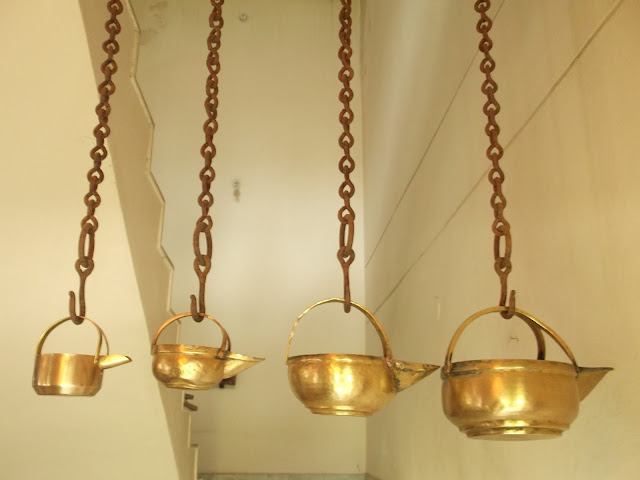 |
| Brass antique serving pots hanging from chain |
Before I talk about these lovely shaped serving pots, I should first talk about the traditional Andhra meal, the main dishes in the meal, how they are presented and served. I will then tell you about how these serving pots are used. We have specially designed pots to serve the liquid variety of the Andhra food and entirely different type of pots to serve the non-liquid type of dishes. The serving pots shown here are to serve Andhra traditional liquid food items like pulusu, charu, perugu , majjiga or challa and payasam.
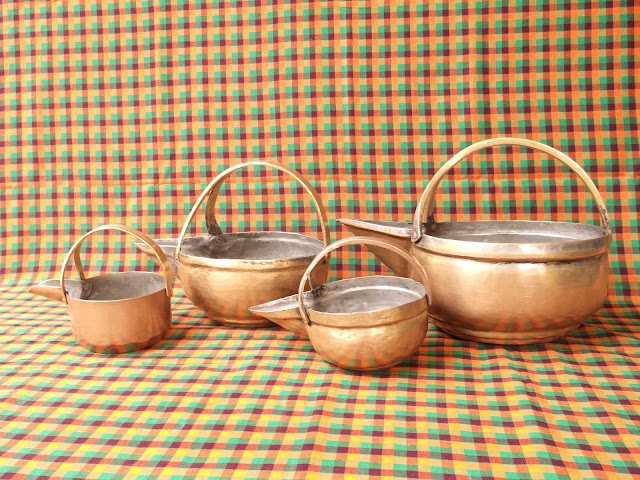 |
| Antique serving pots arranged as a group |
Andhra food is very spicy and hot when compared to other Indian foods. Andhra is the hotbed for red chilies which makes the dishes very spicy or fiery. The traditional dishes of Andhra are absolutely mouthwatering with a liberal use of hot spices. Relishing Andhra’s food is a virtual elaborate romance with the taste buds. Traditionally the meal is served in Arati auku (plantain leaf) or Vistari auku (a plate made by stitching together dry vistari auku leaves). The main characteristics of Andhra food are liberal use of a variety of Ooragayalu (pickles ), Podulu (powders) and Pachallu (chutneys)
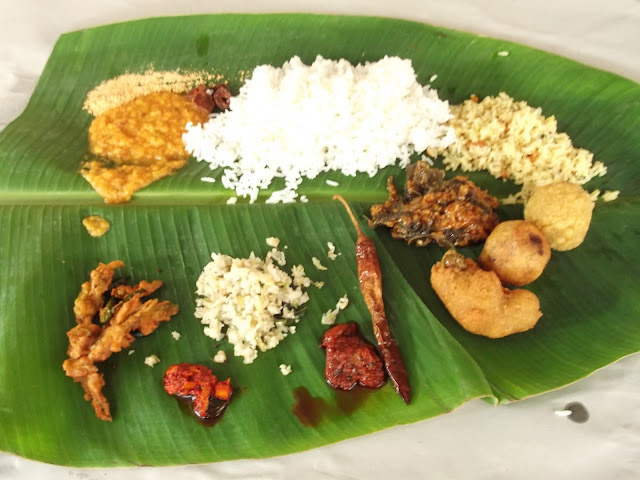 |
| Andhra traditional food served on a plantain leaf |
Traditional Andhra lunch is very elaborate and consists of a variety of dishes. Andhra being the rice bowl of India, the main staple food item of Andhra is rice and it is taken mixed with other dishes and ghee. Andhra food items are well balanced and consist of dishes of liquid items, semi-liquid items and solid items. Andhra traditional lunch starts with Modati mudda (first morsel of rice) and is also known as Paragadupu. This is usually a small quantity of rice mixed with hot ghee or rice mixed with chutney or pickles typically made from gooseberry, lime, mango (aavakaya) or podi (powders) like parupu podi, coriander podi, pudina podi, sesame seeds podi or curry leaves podi mixed well with hot ghee. This may be to grease the throat and to activate the saliva glands for smooth inward journey of the hot and spicy food.
The most important aspect of Andhra food is Popu also called Talimpu. Popu is basically certain spices and pulses fried in oil and added to the main dish. The Popu gives the unique flavor and distinct taste to the dish. When the Popu is done in the kitchen the flavor spreads throughout the surrounding areas and people in that area gets their saliva glands tickled and the pungent smell of the red chilies fried in the popu stimulate the nose buds resulting in mild cough or sneezing. The quality of the Popu is a main contributing factor about the taste of the item.
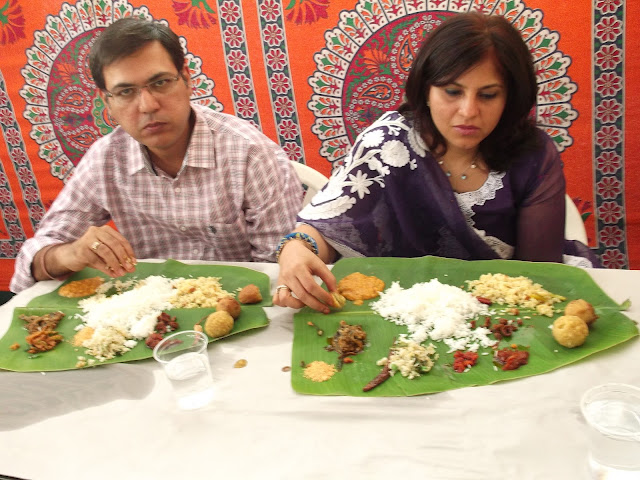 |
Couple relishing an Andhra traditional meal
|
Then the main course of the lunch starts with variety of items and some of them are listed below
Mudda pappu– kandipappu or red gram boiled in plain water and salted.
Koora– vegetables cooked with spices and seasoning.
Vepudu- fried vegetables mixed with spices.
Pulusu- Vegetables or greens cooked in tamarind juice, spices and seasoned. The pulusu made from special type of vegetables like yellow pumpkin is also known as Dappalam. This is a liquid item.
Pachi pulusu – It is similar to Pulusu but the tamarind juice or the ingredients are not cooked. Only raw materials are used. This is a liquid item.
Charu- Tamarind juice diluted with water and boiled with spices with seasoning.This is a liquid item.
Pickle– for Andhras pickle means only Avakaya, a raw mango spicy pickle.
Chutney – invariably Gongoora Chutney .Andhras adore Gongoora chutney prepared from Gongoora leaves.
Podi – powder of lentils mixed with powdered spices.
Appadalu – a round thin crisp preparation rolled out of lentils and spices paste and deep fried.
Vadiyalu – a small cup size mixture of Ash guard, urad dal and spices, sun dried and fried.
Oora mirapakayalu– dried chilies in salted Indian yogurt and deep fried.
Neyya – clarified butter. This is a most important item in the Andhra food since it is mixed with rice along with every item except curds .
Perugu – curds or Indian yogurt .This is semi-liquid item.
Majjiga or challa– curds diluted by churning with water. This is a liquid item. Invariably the Andhra meal ends with curd or buttermilk. If somebody is taking curd with rice it means that he is ending his meal.
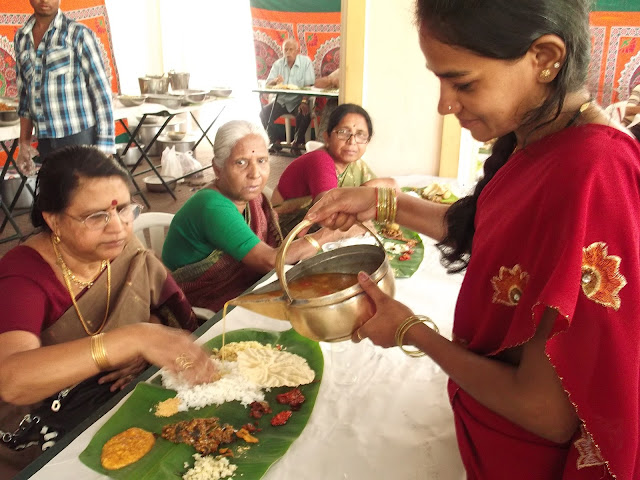 |
| Lady serving Mukkala pulusu to a guest using antique Serving pot |
Apart from these courses of meal, other Andhra special sweet and hot items are served on special occasions.
Payasam– Rice cooked in milk with sugar or jaggery. Dry fruits are added.
Bobbatlu – mixture of boiled Bengal gram and sugar covered with a white wheat powder paste and flattened for a round shape and shallow fried with Ghee or oil on a pan.
Boorelu- mixture of Bengal gram, sugar and spices to a small ball dipped in a paste of black gram and rice powder and deep fried. For an ultimate taste, it is eaten with hot ghee.
Pootha Rekulu – A roll of rice paper filled with ghee, powdered sugar, cardamom powder and dry fruit cuttings.
Ariselu– Mixture of rice powder and jiggery syrup made into flat round shape and deep fried.
Kajalu – white wheat powder paste rolled into oval shape, fried in oil and soaked in sugar syrup.
Garelu– paste of soaked black gram made into a flat round shape with a hole in the center and deep fried in oil.
Pulihora- cooked rice mixed with tamarind paste and special type of Popu.
Aavadalu – Garelu soaked in Curds and sprinkled with spices.
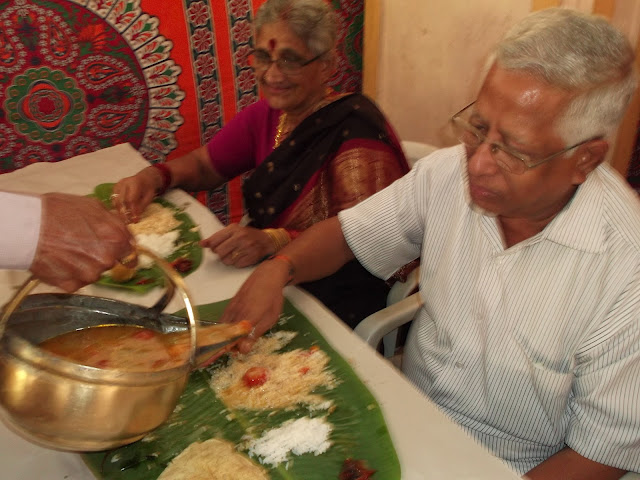 |
| Couple enjoying service from antique serving pot at a community Andhra feast |
The Andhra food mentioned here is of traditional vegetarian food. Andhra is also known for its spicy but delicious non-vegetarian food also.
Serving pot from temple in Teki Village
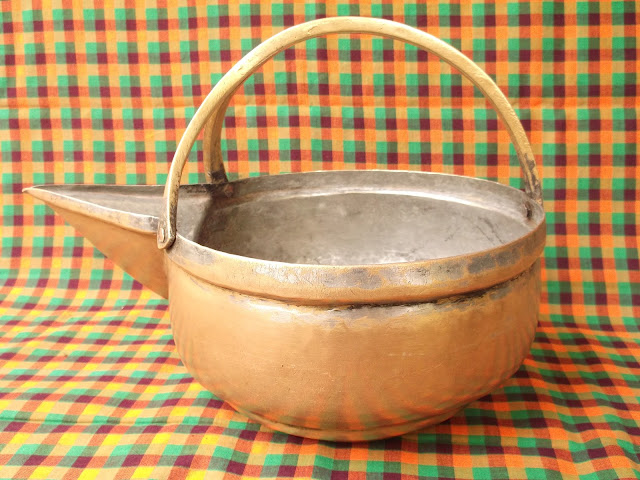 |
| Serving pot from the temple in Teki village |
This serving pot is designed and crafted to serve liquid food items and is called Gokarnam in Sanskrit language. In Telugu language also it is called Gokarnam. This serving pot acquired this name may be due to the snout of the pot which resembles that of the ear of the cow (“go” meaning cow and “karnam” meaning ‘ear’ in Sanskrit language). There is a bowl or a pot to hold the liquid and there is a snout strategically placed to pour the liquid directly into the plate of the consumer. The serving pot has a beautifully designed handle to help carry the pot and as a grip for serving the food item. One side of the handle is forked into two sections and riveted to the two sides of the snout and the other end is riveted to the rim opposite to the snout.
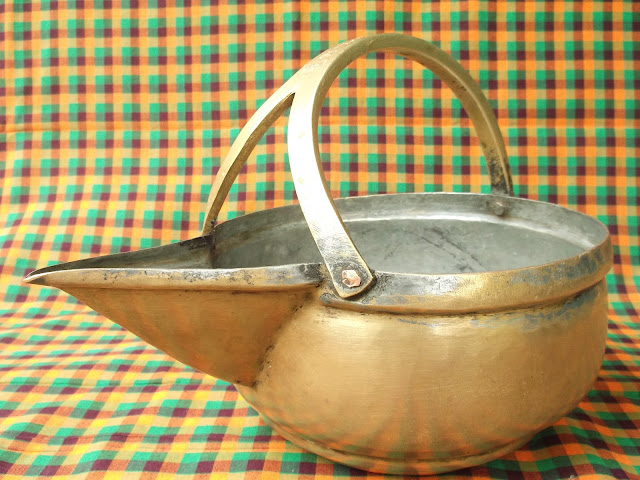 |
| Picture of Gokarnam showing handle riveted to the body at 3 locations |
This type of riveting the handle to the three sides of the rim of the pot gives robust balance and steady grip and prevents any chances of tilting the pot at the time of the serving of the liquids for which it is designed. Because of this wonderful design of snout to the pot no separate spoon or ladle is required to serve the liquid item it holds and the liquid can be directly poured into the plate of the consumer by giving a slight twist to the wrist.
Teki is a village in east Godavari district of Andhra Pradesh state. The temple in Teki prepares and serves food to the villagers on important occasions like temple festivals. For this purpose the temple has their own collection of cooking vessels and serving pots. Since brass vessels are difficult to maintain, the temple authorities decided to sell the brass items and purchase stainless steel items which are easy to maintain. I came to know about their disposal of these antique vessels and rushed to the village and purchased this rare classic serving pot. There is an inscription on the handle of the pot written in Telugu language reading “Sree// cheruvu vadda gudivi “meaning this item belongs to the pious temple near the tank.
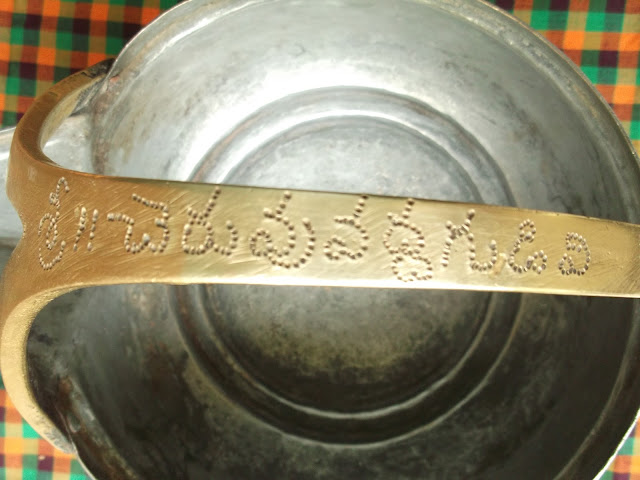 |
| Picture showing inscription on the handle in Telugu language reading “Sree// cheruvu vadda gudivi |
This pot is handmade out of brass and we can see the hammer stroke marks that give the beautiful shape to this pot. This item is dedicatedly made for the temple of Teki. The craftsman who made this pot had to conceive the function and purpose of this pot and craft accordingly.
The second serving pot from Teki village with inscription “Vee:Bhu” in Telugu language
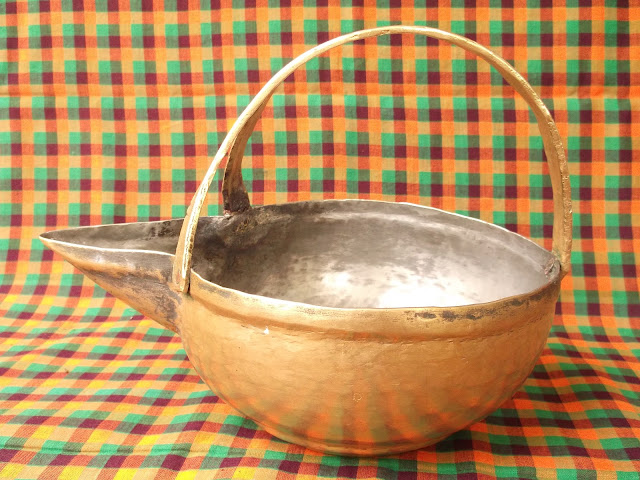 |
| The second serving pot from Teki village with “Vee:Bhu” inscription |
When I purchased the serving pot from the temple authorities in the village Teki, there was one gentleman watching this deal and latter approached me introducing himself as a landlord and a resident of Teki village and that he has a serving pot similar to the one belonging to the temple serving pot. He also volunteered to sell the item to me because he was very much impressed with my passion to collect old articles and preserve our heritage and culture. I was excited since I was getting a similar serving pot to my collection and immediately told him my thanks to his offer and my willingness to purchase his item. He took me to his house, instructed the ladies in the house to fetch the serving pot after cleaning the pot. A clean and neat serving pot that is exactly similar to the one from the temple was handed over to me. I saw an inscription in Telugu language on the handle of the pot reading “Vee:Bhu”.
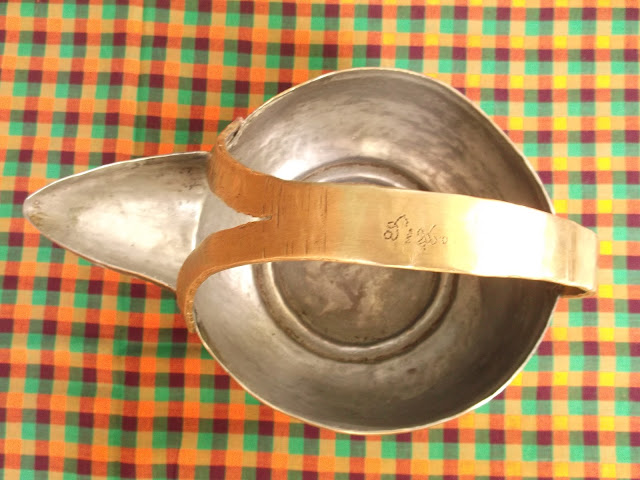 |
| Picture showing the handle of the pot with “Vee:Bhu” inscription in telugu |
I asked him about the meaning of the Telugu letters ‘Vee’ and ‘Bhu’. He mentioned that these are the shortened form of the name of his great grandfather who acquired the pot and inscribed his name in abbreviation. This is how I have collected this pot.
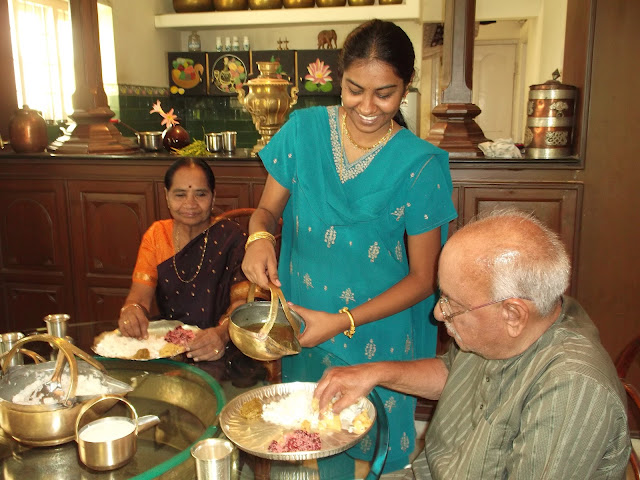 |
| A charming girl serving Charu from the Gokarnam with Vee:Bhu mark |
It is also made out of brass and handcrafted and the hammer marks are very prominently visible. These hammer marks give beauty to the pot and also give authenticity to the pot that it was handcrafted by an artisan. These hammer marks are to the pot as the weapon scar marks were to a warrior in the olden days of kings and kingdoms.
The serving pot from YK’s ancestors
The pot shown here is from my family collection passed on to me from my ancestors. It has been present from my grandfather’s time and we do not know really how old it is since my grandfather was unable to identify from whom he got it. From the time perspective and from the looks and shape of the pot, it is evident it is really old. I remember that these brass serving pots were not used daily and were kept in the loft .Whenever there is an occasion for mass feeding or a ceremonial meal is served to guests on special occasions like pooja or festivals or special events, these pots are taken out from the loft, cleaned with a paste of tamarind juice and charcoal ash and then they are used for serving liquid food items.
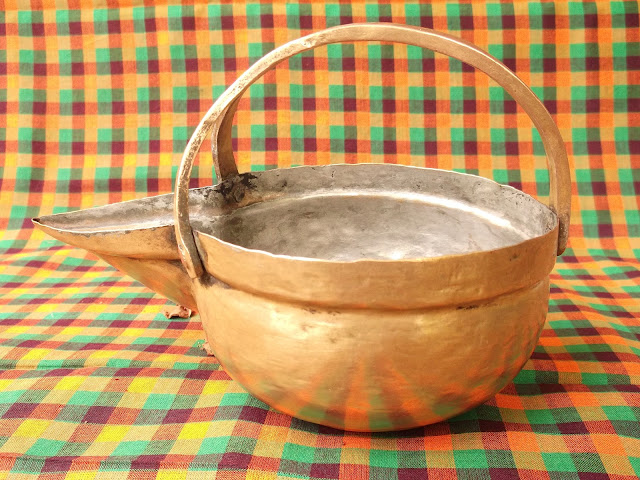 |
| The serving pot from YK’s ancestors |
There is another method of serving liquid food items by using a bucket and a ladle. The liquid food item is kept in the bucket held by the bearer in the left hand and the liquid item is served to the guest with a ladle held in the right hand. In this method both the hands are used and occupied. There is a chance of spillage or drippings of the liquid when taken out from the bucket with a ladle and while pouring the ladle full of liquid onto the guest’s plate. By using the antique liquid serving pot you use only the pot and the liquid is directly served to the guest by pouring it onto their plate. It is a clean operation and there is no chance of any spillage or wastage. The service is also fast in the case of serving pot since you are handling only one vessel and the service is done in one shot.
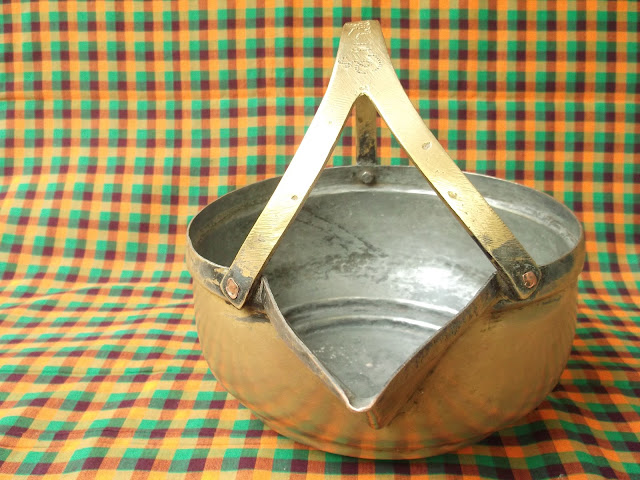 |
| The Gokarnam with Tin metal coating inside the pot. The gray color inside the pot is due to the Tin coating. |
The inside part of these brass serving pots are lined with Tin metal coating which is known as Tagaram poota or Kalayi poota in Telugu. This is to prevent the juices of tamarind and other spices interacting with the brass metal and creating chemical reactions. The layer of Tin metal neutralizes these chemical reactions.
The serving pot purchased from an antique dealer
This serving pot is not very old. The pot was made by pressing a brass sheet into the required shape. There are no hammer marks and hence is not handmade. The lines are sharp and clean indicating a machine make. The shape of this pot is very cute and the riveting is clean and the forking of the handle is beautifully done.
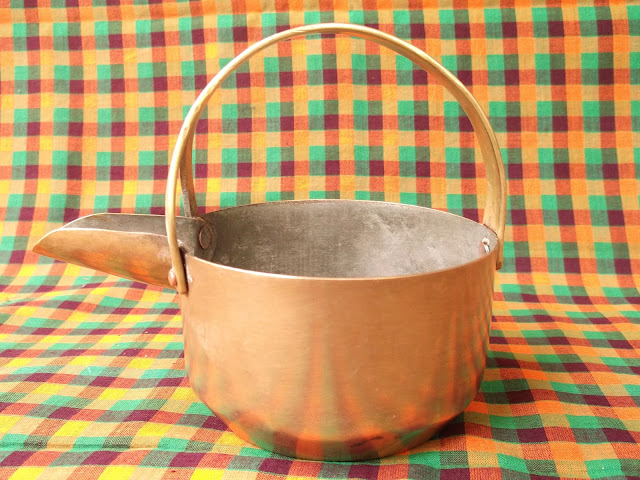 |
| Picture showing the serving pot from the antique dealer |
I purchased this pot from an antique dealer in Chennai, Tamil Nadu state. The people of Tamil Nadu use Sambar (a liquid type of food item containing dal, vegetables and spices) in their daily meals as well as during special occasions. They use this type of serving pot to serve sambar. This pot has been with me for about 30 years.
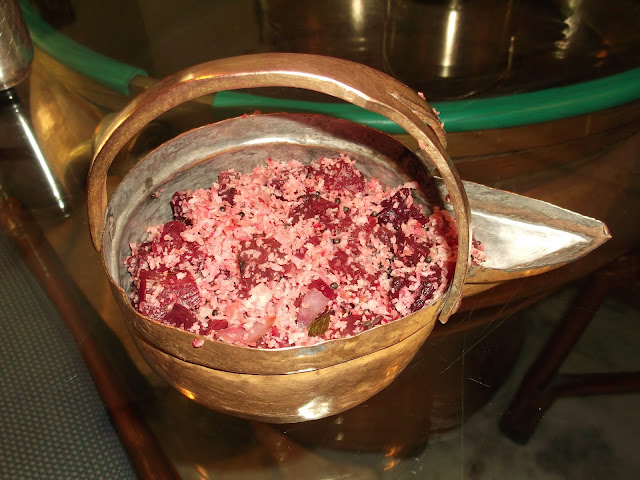 |
| Picture showing antique serving pot with dry curry of Beetroot and coconut gratings |
The serving pots can also be used to serve solid or semi-solid foods by using a serving spoon. Though the handle of the pot is a bit of a hindrance to the free movement of the serving spoon, it has the advantage of portability due to the long and sturdy handle.
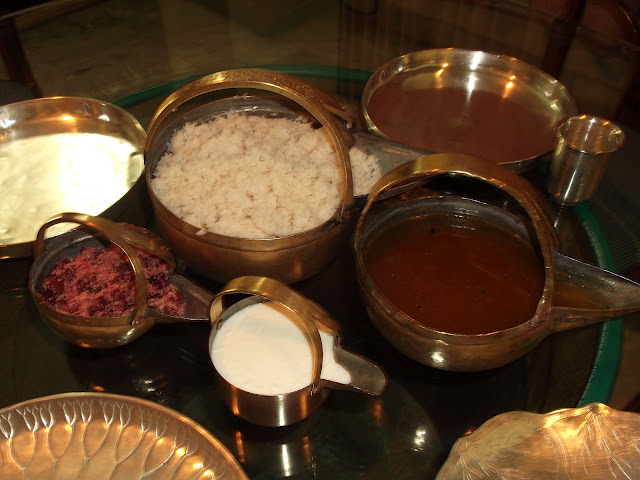 |
| Antique serving pots with liquid and solid items |
These wonderful serving pots are the mute spectators of the glorious era gone by. I remember that whenever there was a marriage or a function in any body’s house in our village Someswaram, they used to come to our house and borrow the serving pot. After the function they used to return to us .I wonder how many marriages and functions the pot has served. Similarly the serving pot from Teki temple must have served many temple ceremonies and feasts and now they adore my house with their colorful presence. I am really proud of these collections.
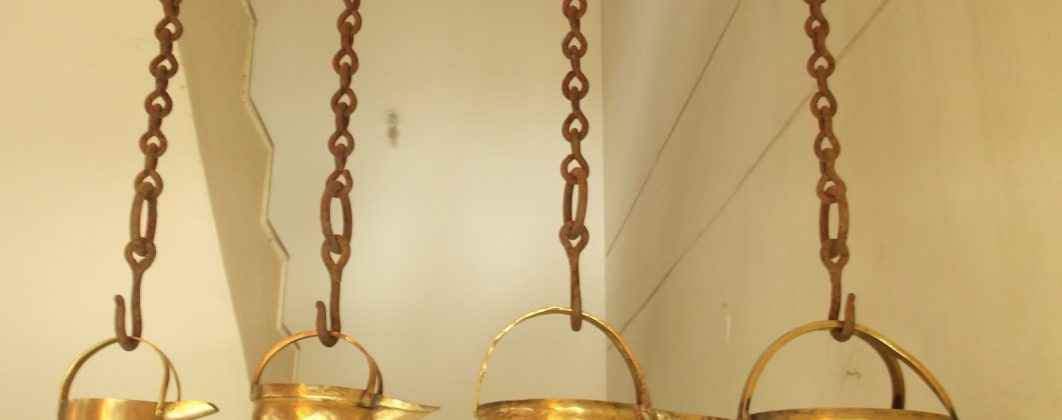








8 Responses
Wow! Feels really nice to read this article. Antiques and traditions are hardly preserved these days and good to see you’re keeping them with you.
yk your antique collection is wonderful! Keep going!-Ramana
YKM garu, Great collection. This reminded me of a small story(PULUSU GOKARNAM ANTIMA YATRA) I have written for my college magazine long back, now I have to locate it (may be it will be another antique).
Dear Ramakrishna.Thanks for your kind encouraging words.I love to collect these cultural antiques that tell us the way of life few generations before.Your PULUSU GOKARNAM ANTIMA YATRA story is very interesting.Try and locate it.It will make a wonderful antique and an excellent conversation piece.
Good product
Dear Pedda nannagaru.. beautiful write up! The way you have explained different Andhra vantakalu, nooru voori poyindi :).haha…Awesome collection andi and good to see Aamma in the photos :).
I second with bannu pedda nannagaru… U made our routine dishes sound even more tastier… Great